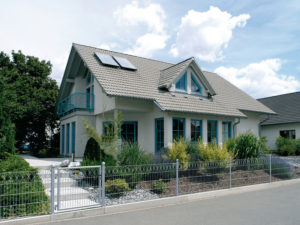By Andreas Capellmann, SCT GmbH
Do suppliers of DIY markets such as GAH Alberts Gust. Alberts GmbH & Co. KG always offer their customers full shelves and good margins, it is not enough to feed the JIT Supply Chain 4.0 from the finished goods warehouse or the last available machine. If you want to be successful in the long term, you need a much more far-reaching replenishment strategy, as this is the only way to reduce finished goods inventories while maintaining maximum delivery readiness and thus save enormous costs.
DIY stores always want full shelves – ideal with fast-moving items and good margins. Some suppliers provide their own rack jobbers or hire sales service companies to present a perfectly maintained range at all times. With solutions such as ‘Logistics 4.0’, the aim is to bring sales figures even closer to the point and ideally respond with batch size 1. But all these efforts do not lead to success if suppliers always want to meet these sometimes very fluctuating demand reports as quickly as possible, for example within 24 hours.
To do this, they would have to maintain very high stocks in the finished goods warehouse or JIT capacities for production. Both are superfluous outside peak load times and therefore also expensive and tie up capital. This is why supplying companies are looking for ways to implement all of this more cheaply in order to ultimately be able to offer the construction market attractive prices. The potential is enormous: in addition to the capital commitment, which in itself leads to dead capital, there are even 18 to 30 percent more costs in the inventories, which result from capital costs, insurance, administration, storage capacities and so on. The DIY store has to pay these costs if the logistics chain is not right.
But how can you even increase delivery readiness and reduce inventories at the same time?
Optimize scheduling processes
First and foremost, this is a question of better scheduling processes. For example, fast-moving items can be delivered at shorter intervals. This reduces storage capacity. Products that are rarely in demand are produced on demand and removed directly from the finished goods warehouse. In addition, the logistical decoupling point can be placed as far as possible towards the end of the supply chain through modularization, thus reducing inventories across the entire supply chain. Many logistical variables are also planned by Bauch and executed by hand. Filling a pallet space in the truck with slow-moving items just to save freight costs quickly drives up stock levels. So there is a lot to optimize across the entire supply chain.
GAH Alberts, for example, has managed to significantly reduce its inventories and at the same time increase its delivery readiness. As a manufacturer of fittings, profiles and fencing technology, among other things, GAH was able to reduce inventories by 13 percent in the short term and a whopping 53 percent in nine months.
More than half of the finished goods warehouse was therefore stocked with material that was not immediately required in order to ensure a high level of delivery readiness.
Another supplier for DIY stores in the lighting sector had to overcome the challenge that the components of the products, which are mainly manufactured according to the company’s own designs, were largely procured in China. The delivery times here are between 60 and 150 days. However, the customers, specialist and wholesale companies, demand the highest delivery readiness at all times. Around 20,000 customer order items are received every day, most of them with a delivery time of 24 hours. A sufficiently high stock level is therefore required on the procurement side. However, if the demand situation changes on the customer side, items that were previously procured well in advance are no longer needed and become surplus stock. Such problems therefore need to be managed.
 Managing fluctuations in demand
Managing fluctuations in demand
Almost every company has to contend with fluctuations in demand, be it the introduction of new products or the discontinuation of old ones, competitive campaigns or a general change in demand.
The special feature of GAH Alberts was the fact that the products are subject to extremely strong seasonal behavior, as many materials are manufactured and sold for the garden sector, among other things. During the peak season, the available production capacities are not sufficient to fully synchronize production with the market. This means that the quantities you plan to sell sometimes have to be produced weeks or even months before the planned sales. However, if sales planning is inaccurate, sales cannot be realized due to a lack of material and other materials remain in the warehouse as slow-moving items.
Method and tool skills
Method and tool skills are required for this. At the lamp manufacturer, for example, an extended ABC analysis was carried out. In other words, a classification of the complete range of articles according to
- ABC – economic significance,
- XYZ – Regularity of consumption,
- STU – number of customers per item and
- ELA – Life cycle.
These classification features are important parameters for deciding which planning and scheduling parameters should be set for which item. In addition, a set of rules was drawn up that precisely defines which article classes are to be planned and scheduled and how. With such basic analyses, existing stocks can be quickly reduced and delivery readiness increased at the same time.
But all such analyses and the measures derived from them are not enough if dispatchers are not supported by suitable software, for example. For example, a valve manufacturer had to determine the reporting and safety stocks without system support from the ERP. It was particularly noticeable that the safety stocks were calculated in different ways depending on the responsibility or were merely the result of empirical values. In the disposition of purchased parts, order requirements were not checked on a demand basis, but once a week. Despite the ERP system, the overall process at this point was therefore highly manual, very time-consuming and therefore prone to errors despite the utmost care. In order to be able to use all the “big data” from Supply Chain 4.0 at all, many series and variant manufacturers must first structure and optimize the scheduling processes upstream of the finished goods warehouse or the last production machine before packaging. And that is no trivial undertaking.
 Good disposition is a complex matter
Good disposition is a complex matter
The complexity of scheduling can be seen from the amount of master data required alone: Depending on the cut of the article, you have to take care of up to 130 logistical parameters. If you imagine this as a mathematical equation, it is easy to understand that you cannot calculate it in your head. However, major mistakes are made when individual parameters are combined for the sake of simplicity. For example, safety stocks for fluctuating demand, safety stocks for fluctuating production times and safety stocks for fluctuating delivery times of the upstream suppliers are mapped in a common safety value. Cumulatively, this can only lead to more stock. Strongly oscillating graphs with many different peaks become curves until you finally arrive at a “smooth” forecast, which, however, only covers up the problems and ends up costing a lot of money. Optimal scheduling therefore also requires correspondingly differentiating tools.
ERP alone is not enough
Most companies already have a suitable software tool for scheduling purposes: the existing ERP system or corresponding extensions. However, ERP systems originally have other tasks, so that the options for demand forecasting and scheduling are usually very limited and these functionalities are not sufficiently differentiated. For example, there are practically no automatic mechanisms for the continuous optimization of scheduling parameters. In addition, virtually all known ERP systems work exclusively with statistical methods that assume a so-called “normally distributed” demand, such as mean value methods or exponential smoothing. In practice, however, normally distributed demand is practically never encountered. Rather, demand is subject to constant seasonal, cyclical or other fluctuations. As a result, calculations based on the assumption of normally distributed demand lead to systematically incorrect demand forecasts and inventory errors of up to 40%.
Precise special tool for dispatchers
It therefore remains to be said that forecasting and scheduling tasks can be performed with an ERP system. However, the result is usually far from optimal. To achieve this, dispatchers need advanced planning and scheduling software, or APS software for short. Such precision tools for specialists, such as DISKOVER SCO from SCT, are usually much more precisely tailored to scheduling tasks than generalist ERP systems and offer much finer, range-oriented forecasting functionalities for improved planning, for example, and can therefore predict actual demand much more accurately. For the “generalists” – i.e. the ERP providers – this specialist market is of little interest, as very in-depth and specific specialist knowledge is required here. Nevertheless, there is a great need for action, as companies with a diverse portfolio can regularly save hundreds of thousands of euros in stored material and therefore dead capital. Important capital that can be invested in solutions for Supply Chain 4.0. Incidentally, APS software is generally suitable for companies with a sales volume of around EUR 10 million or more. There are basically no further restrictions for DIY suppliers, although the range itself should include a certain level of complexity. Suitable sectors range from A for fittings, bathroom accessories, fittings and hardware, electrical accessories, small ironmongery, lights and tools to Z for fencing elements. The fact that the introduction of such a system requires a certain amount of preparation should be clear to every user who also uses ERP systems. The software providers also know suitable consultants for this.
Image rights: © GAH Alberts GmbH & Co KG



